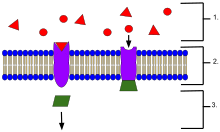
- Ligands, located outside the cell
- Ligands connect to specific receptor proteins based on the shape of the active site of the protein.
- The receptor releases a messenger once the ligand has connected to the receptor.
In biochemistry and pharmacology, receptors are chemical structures, composed of protein, that receive and transduce signals that may be integrated into biological systems.[1] These signals are typically chemical messengers[nb 1] which bind to a receptor and produce physiological responses such as change in the electrical activity of a cell. For example, GABA, an inhibitory neurotransmitter, inhibits electrical activity of neurons by binding to GABAA receptors.[2] There are three main ways the action of the receptor can be classified: relay of signal, amplification, or integration.[3] Relaying sends the signal onward, amplification increases the effect of a single ligand, and integration allows the signal to be incorporated into another biochemical pathway.[3]
Receptor proteins can be classified by their location. Cell surface receptors, also known as transmembrane receptors, include ligand-gated ion channels, G protein-coupled receptors, and enzyme-linked hormone receptors.[1] Intracellular receptors are those found inside the cell, and include cytoplasmic receptors and nuclear receptors.[1] A molecule that binds to a receptor is called a ligand and can be a protein, peptide (short protein), or another small molecule, such as a neurotransmitter, hormone, pharmaceutical drug, toxin, calcium ion or parts of the outside of a virus or microbe. An endogenously produced substance that binds to a particular receptor is referred to as its endogenous ligand. E.g. the endogenous ligand for the nicotinic acetylcholine receptor is acetylcholine, but it can also be activated by nicotine[4][5] and blocked by curare.[6] Receptors of a particular type are linked to specific cellular biochemical pathways that correspond to the signal. While numerous receptors are found in most cells, each receptor will only bind with ligands of a particular structure. This has been analogously compared to how locks will only accept specifically shaped keys. When a ligand binds to a corresponding receptor, it activates or inhibits the receptor's associated biochemical pathway, which may also be highly specialised.
Receptor proteins can be also classified by the property of the ligands. Such classifications include chemoreceptors, mechanoreceptors, gravitropic receptors, photoreceptors, magnetoreceptors and gasoreceptors.
- ^ a b c Guyton, Arthur C.; Hall, John E. (2016). Guyton and Hall Textbook of Medical Physiology. Philadelphia, PA: Elsevier Saunders. pp. 930–937. ISBN 9781455770052. OCLC 1027900365.
- ^ Mihic, S. John; Harris, R. Adron (1997). "GABA and the GABAA Receptor". Alcohol Health and Research World. 21 (2): 127–131. ISSN 0090-838X. PMC 6826832. PMID 15704348.
- ^ a b Alberts B, Bray D, Hopkin K, Johnson A, Lewis J, Raff M, Roberts K, Walter P (2014). Essential Cell Biology (Fourth ed.). New York, NY, USA: Science. p. 534. ISBN 978-0-8153-4454-4.
- ^ Gotti, Cecilia; Marks, Michael. J.; Millar, Neil S.; Wonnacott, Susan (16 September 2019). "Nicotinic acetylcholine receptors (version 2019.4)". IUPHAR/BPS Guide to Pharmacology CITE. 2019 (4). doi:10.2218/gtopdb/F76/2019.4. Retrieved 17 November 2020.
- ^ Malenka RC, Nestler EJ, Hyman SE (2009). "Chapter 9: Autonomic Nervous System". In Sydor A, Brown RY (eds.). Molecular Neuropharmacology: A Foundation for Clinical Neuroscience (2nd ed.). New York: McGraw-Hill Medical. p. 234. ISBN 9780071481274.
Nicotine ... is a natural alkaloid of the tobacco plant. Lobeline is a natural alkaloid of Indian tobacco. Both drugs are agonists [of] nicotinic cholinergic receptors ...
- ^ "Curare Drug Information, Professional". Drugs.com. Archived from the original on 16 November 2018. Retrieved 8 December 2020.
Cite error: There are <ref group=nb> tags on this page, but the references will not show without a {{reflist|group=nb}} template (see the help page).